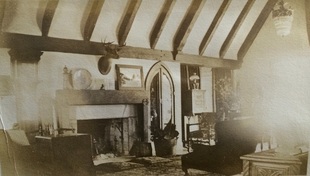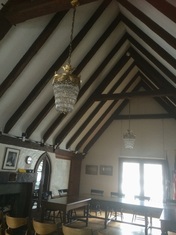Restoration of the Marcham Hall Chandeliers
 Dorothy Cornell photograph of her studio, showing the chandeliers. Photo courtesy of The History Center in Tompkins County.
Dorothy Cornell photograph of her studio, showing the chandeliers. Photo courtesy of The History Center in Tompkins County.
Dorothy Cornell, a granddaughter of Ezra Cornell, built Marcham Hall, which she named Stonecroft, between 1926 and 1928. She had the two fixtures, which are excellent examples of the Art Deco “upside-down wedding cake” style of chandelier that was very popular in the 1920s and 30s, installed in this room, which she called her “studio.” Sometime after she sold the building around 1937 they were taken down, likely in 1963--six years before the village acquired the building--judging from the newspaper they were wrapped in. Fortunately, a careful wrapping job was done; all the parts were left intact just waiting to be found in 2013.
Like the land the house stands on, the fixtures were a gift to Miss Cornell from her sister and brother-in-law, Eunice Cornell Taylor and Charles Taylor, who lived next door in the red-brick Kline Farmhouse (what is today the Warren Real Estate building) at 830 Hanshaw Road. The Taylors apparently brought them back to Ithaca from the Hotel Martinique in New York City where Charles Taylor had been proprietor. Very similar fixtures may be found in photos of public rooms in the Martinique, which was a notable example of Beaux Arts architecture designed by the architect of the Waldorf Astoria.
Like the land the house stands on, the fixtures were a gift to Miss Cornell from her sister and brother-in-law, Eunice Cornell Taylor and Charles Taylor, who lived next door in the red-brick Kline Farmhouse (what is today the Warren Real Estate building) at 830 Hanshaw Road. The Taylors apparently brought them back to Ithaca from the Hotel Martinique in New York City where Charles Taylor had been proprietor. Very similar fixtures may be found in photos of public rooms in the Martinique, which was a notable example of Beaux Arts architecture designed by the architect of the Waldorf Astoria.
According to Michael Montgomery, a vintage lighting restorer in Aurora, N.Y., in his work over twenty-five years, he has been in only “half a dozen homes with this quality of fixtures.”
|
They are made of solid brass with brass chains and canopies that fasten to the ceiling above. The round swag pattern on the body of the fixtures is quite unusual for its floral decoration. The four circles underneath have tiny openings where the glass prisms found nearby in the attic are meant to be fastened, sending off light from the five bulbs inside. The bulb sockets that were called “fat boys” were standard until the 1940s but accept present-day light bulbs. They are a particularly fine example of their kind, most of which had neither such ornate design nor quality of workmanship
|

